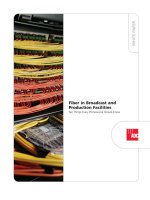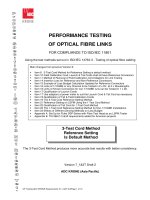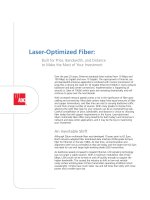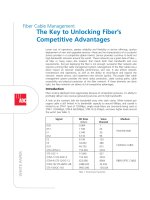Tài liệu ADC KRONE - Guide - FTTP - A Deployment guide for Network Manager docx
Bạn đang xem bản rút gọn của tài liệu. Xem và tải ngay bản đầy đủ của tài liệu tại đây (175.69 KB, 21 trang )
Fiber To The Premises
A Deployment Guide for Network Managers
PLANNING GUIDE
There has never been more pressure on bandwidth and cable plant. The resources of cable
providers and telephone companies are being stretched to the limit due to the addition of
such items as second lines for children, computers, security and the advent of the “smart
house.” This situation is compounded by the race to offer the telecommunications “triple
play” – a combination of voice services; cable TV and video on demand; and high-speed
data and Internet access. Until now, phone companies have lacked the video portion, since
their existing copper infrastructure has had only enough bandwidth to support broadband
and voice.
For branch offices, small businesses and homes seeking such services, the traditional solutions
offered by telecommunications companies have been T1 lines and DSL. T1 lines are often
expensive and DSL has been plagued with performance issues. And with speeds hovering
around the 1.5 Mbps, neither technology offers the ability to fully support triple play.
Enter Fiber-to-the-Premises (FTTP). The new FTTP technology is expected to solve this
problem—transferring data at speeds from 622 Mbps to 2.5 Gbps per second to users and
155 Mbps to 622 Mbps to the network—much faster than cable modems, T1s or DSL.
According to analysts at In-Stat/MDR, the number of FTTP subscribers worldwide will grow
at a compound annual rate of 49% between 2003 and 2007, by which time the cost of
deploying fiber could drop to below $500 per subscriber.
The North American rollout has begun and will reach completion over the next decade—
taking place in both existing and greenfield developments.
The purpose of this guide is to provide you an understanding of the issues surrounding FTTP.
What are the challenges in FTTP implementations? When does it make economic sense?
What should you be doing now to take advantage of the next phase of fiber optic “roll-
out” in order to optimize your telecommunications infrastructure?
If you don’t have the answers to some of these questions or you lack a
complete understanding of FTTP, this guide is a great place to start.
to the FTTP Deployment Guide for Network Managers
Welcome
Charting the Future Direction of
FTTP Deployment
How to Use the Deployment Guide:
Sections 1 through 5
Fiber To The Premises—A Deployment Guide for Network Managers
The FTTP Deployment Guide is designed as a hands-on
reference document. We invite you to share this
guide with your staff and use the information to build
your own “Blueprint for FTTP Success.”
It has the potential to help you and your staff in the
following ways:
• Analyze the strengths and weaknesses of your
current telecommunications infrastructure.
• Explore strategies for improving operational
efficiency.
• Plan for the inevitable transition to triple play
service delivery.
The guide is broken into five easy-to-navigate sections.
While this format allows you to pick and choose which
sections to view, the most effective way to use this
document is to work through each section in order.
You will be asked to complete an FTTP network audit,
which offers the dual benefit of allowing you to docu-
ment your current situation and providing ADC with
the necessary information to answer your tough FTTP
questions.
The guide also provides you with insight into design
choices for effective FTTP infrastructure, as well as case
histories from real-world FTTP implementations.
Section 1
Auditing Your FTTP Network Deployment
Section 2
Service and Technology Considerations
Section 3
Your Blueprint for FTTP Success
Section 4
Cable and Drop Wire Selection Process
(Provided courtesy of Sumitomo Electric
Lightwave)
Section 5
Lessons Learned: Actual FTTP Deployment
Scenarios
Page 3
Section 1:
Auditing Your FTTP Network Deployment
Successful FTTP deployment begins with building a solid
network foundation. In Section 1, we examine the
objectives of your FTTP deployment, your network infra-
structure considerations, and the operational require-
ments you may face by asking informed questions.
After you’ve completed this audit and carefully
examined the important aspects of FTTP deploy-
ment, call 1-866-210-1122 and let ADC answer
your tough questions.
Do you have plans to deploy FTTP, or are you considering
deploying FTTP?
Deploying now
In the next 6 months
In the next year
Considering
Have you chosen a “Design Engineering” consultant?
Yes (Name:
)
No
Need assistance
Is your FTTP deployment...
Greenfield
Overbuild
Own overbuild
Competitor
Refurbish
Unknown
Have you chosen an active component supplier?
Yes (name supplier)
APON (
)
EPON (
)
BPON ( )
GPON (
)
P2P Ethernet (
)
No
Need assistance
Have you chosen a passive, outside plant (OSP) compo-
nent supplier?
Yes (Name:
)
No
Need assistance
What business challenges lead you to consider FTTP?
Increasing revenue/sales
Retaining subscribers
Supporting community quality of life
Minimizing long-term maintenance costs by
retiring copper plant
Other ______________________
Have you built a business plan for FTTP? If so, what
metrics do you target? (list metrics)
Revenue/subscriber (_____________
___________)
Cost/homes passed (_________________
_______)
MTTR- Mean-Time-To-Repair (____________ ___
)
Cost/truck roll (____________________________
)
Provisioning (_____________________
_________)
Other_______________________
Are you actively deploying other access technologies?
Please check all that apply.
DSL
Video
Data services
Voice services
TI/T3
Wireless
Satellite
Other ___________
At what stage are your FTTP projects?
Activating service
First office application and/or field trials
Vendor selection
Collecting information from vendors
Securing funding/budgets
Other ___________
What process will you use to select vendors?
RFI
RFP/RFQ
Sole source
Fiber To The Premises—A Deployment Guide for Network Managers
Page 4
Section 1:
Auditing Your FTTP Network Deployment
What services will you offer over your FTTP network?
Voice
TR008/GR303
Multiple lines
T1/T3 (fractional T1)
VoIP
Video
Video overlay with On-Demand/Pay-Per-View
Video overlay without On-Demand/ Pay-Per-View
QAM 256
Switched digital video
HDTV
IPTV
Data (tiered service levels)
Security
Meter reading (municipalities and utilities)
Interactive gaming
Other ___________
Which architecture type are you deploying?
Passive Optical Network (PON)
Point-to-Multipoint
Point-to-Point Ethernet
Point-to-Point ATM
SONET Ring
Other ___________
Which overall approach do you favor for your OSP
network?
Aerial
Direct burial
Above ground cabinet
Above ground access terminal (pedestal)
Unknown
Which additional considerations do you favor for your
OSP network?
Splicing
Connectorization
Combination of both
Unknown
Other _____________
Have you chosen a splitter architecture?
Distributed/Cascaded
Centralized
Unknown
How many “homes passed” does your FTTP network
serve when fully deployed?
100 or less
101 to 500
501 to 1000
1001 to 5000
5001+
What initial “take-rate” is expected?
0%
1% to 25%
26% to 50%
51% to 75%
76+
How many total subscribers do you expect your FTTP
network to serve when fully deployed?
100 or less
101 to 500
501 to 1000
1001 to 5000
5001+
If “currently deploying,” what percent of your potential
subscribers are currently “turned up?”
0%
1% to 25%
26% to 50%
51% to 75%
76+
How would you rate the current state of fiber expertise
among your technicians?
Excellent: They are thoroughly trained in FTTP and
understand the nuances of fiber optic cable
management and slack storage.
Fair: While some are experienced in FTTP, many
technicians lack familiarity with the technology.
Poor: We need to thoroughly train most of our
staff in FTTP.
Fiber To The Premises—A Deployment Guide for Network Managers
Page 5
Fiber To The Premises—A Deployment Guide for Network Managers
Page 6
If you could offer FTTP now, what take-rates would you
anticipate?
Less than 10% “homes passed”
10% to 24% “homes passed”
25% to 49% “homes passed”
50% or greater “homes passed”
What environmental extremes will your network face?
Temperature extremes
Flooding
Earthquakes/seismic activity
Snow/ice
Unknown
What would you say are the most critical FTTP chal-
lenges for you to overcome?
1.
2.
3.
What right-of-way constraints or community covenants
impact your infrastructure options? (i.e. moratorium on
“above ground” facilities, ROW federally mandated)
1.
2.
3.
Section 1:
Auditing Your FTTP Network Deployment
Page 7
Section 2:
Service and Technology Considerations
Today’s service providers require certain service and
technology considerations to be satisfied as part of
deciding on the best FTTP architecture for their needs.
If the resources are going to be committed to build new
infrastructures or overbuild existing infrastructures, it
must be done right the first time. To accomplish this,
the following factors must be taken into consideration
as you develop your deployment objectives:
1. Maximize Revenue Opportunity
This is achieved by delivering all services: voice, video
and high-speed data. The primary driver for considering
an optical access system is the need to deliver the broad
range of services demanded by residential customers.
This translates into carrier quality plain old telephone
service (POTS), cable TV (CATV) and broadcast quality
entertainment video and Internet access. All three must
be provided in a manner consistent with subscriber
expectations such as service quality, ease of use and
support for all associated features. POTS and CATV
have especially high, well-developed subscriber expecta-
tions that must be met, as opposed to Internet, where
the expectations continue to evolve.
2. Align Revenue to Costs
There is extensive evidence from FTTP projects around
the country how varying take-rates can impact prof-
itability and drain capital from more productive uses,
such as the creation of advanced services. The challenge
is to create an infrastructure that maintains capital
expenditure as close as possible to revenue generation
while simultaneously reducing operating expenses so
investment in new services is possible.
Any FTTP business plan should incorporate a combina-
tion of low costs, exceptional service, and leading-edge
technology to increase both the number of subscribers
and overall subscriber satisfaction.
3. Minimize Subscriber Impact
Minimize impact on customer premise equipment and
wiring. Homes come equipped with twisted pair wiring
for POTS and coaxial wiring for CATV. Most homes have
several analog telephones and answering machines, RF
televisions, VCRs and DVDs. There also may be pre-
existing telemetry equipment for security and utility
management. This set of equipment and infrastructure
is not something that can be easily or cheaply replaced.
Existing subscriber wiring interfaces and subscriber
expectations presuppose an external optical network
terminal (ONT) in which will provide a well-defined
demarcation between the service provider equipment
and the subscriber wiring and customer premise
equipment (CPE). Installation, maintenance and upgrad-
ing of this ONT are accomplished if it is located outside
the subscriber’s premise, as is the case for current
telephony and CATV services.
4. Provide a System Solution
Service providers cannot afford to be in the system inte-
gration business. Full service solutions encompass, by
necessity, a wide range of technologies. The best solu-
tions integrate these disparate technology components
into a system solution that is easy to procure, install,
operate and maintain. An implied aspect of the “system
solution” is accountability on the part of the solution
vendor in making the entire system work.
5. Support a “Near-Term” Business Case
Service providers are drawn to optical access solutions
because they expect service demand and revenue
opportunities to grow rapidly in the near future.
Nonetheless, any solution needs to support a near term
business case based on “today’s” revenue opportunities
and penetration.
6. “Future-Proof” the Network
A service provider network must evolve to satisfy future
demands. Accommodating a growing subscriber base,
increased penetration and expanding services is a key
consideration in building an optical access network.
Service providers should examine the logistical and
financial implications of growing their infrastructure, as
well as the additional maintenance requirements.
The FTTP passive optical network (PON) architec-
ture solution allows for seamless scalability with
minimum cost while still supporting a near-term
business case.
Fiber To The Premises—A Deployment Guide for Network ManagersFiber To The Premises—A Deployment Guide for Network Managers
Fiber To The Premises—A Deployment Guide for Network Managers
Page 8
AT Access terminal
BDCBB Battery distribution circuit breaker bays
BDFB Battery distribution fuse bay
CATV Cable television
CO Central office
CPE Customer premise equipment
FDH Fiber distribution hub
FDT Fiber distribution terminal
FITL Fiber in the loop
FTTB Fiber to the building
FTTP Fiber to the premises
Gbps Gigabits per second
HDT Host digital terminal
LEC Local exchange carrier
Mbps Megabits per second
ODN Optical distribution network
OLT Optical line termination
ONT Optical network termination
ONU Optical network unit
OSP Outside plant
OTDR Optical time-domain reflectometer
PON Passive optical network
POTS Plain old telephone service
UPS Uninterruptible power supply
VAM Value added module
WDM Wavelength division multiplexor
Acronym Key
You will encounter many acronyms throughout this docu-
ment. And while they will be defined along the way, the
following acronym key is provided as an ongoing refer-
ence tool.
Based on the data gathered in Section 1, and the service
and technology considerations discussed in Section 2,
you are now able to begin a blueprint for successful FTTP
deployment in your own network. Creating an infrastruc-
ture that defers capital expenditures as close as possible
to revenue generation, while reducing operating expens-
es, will enable you to invest in new services for your cus-
tomers and new revenue streams for your company.
Along with the addition of FTTP architecture comes a
new set of complicated issues and concerns to challenge
network engineers. Large-scale service distribution
networks require providers to rethink their traditional
methods of building, operating and maintaining the
outside plant (OSP) network. Which overall design, par-
ticularly in terms of which splitter approach to use, will
be most cost-efficient in a particular deployment sce-
nario? Which will provide the necessary flexibility – con-
nectorization, splicing or a combination of both? Which
components will provide the best performance? How
many access points will be needed for testing and
maintaining the system? How much training will techni-
cians need to ensure proper cable management and
slack storage? How does one deal with the new impli-
cations posed by FTTP for the central office (CO)?
In this section, we will show you how the network infra-
structure choices you make today will impact your suc-
cess tomorrow. We’ll guide you through the architectur-
al decisions and equipment selections that impact the
short-term and long-term success of your FTTP network.
Section 3:
Your Blueprint for FTTP Success









